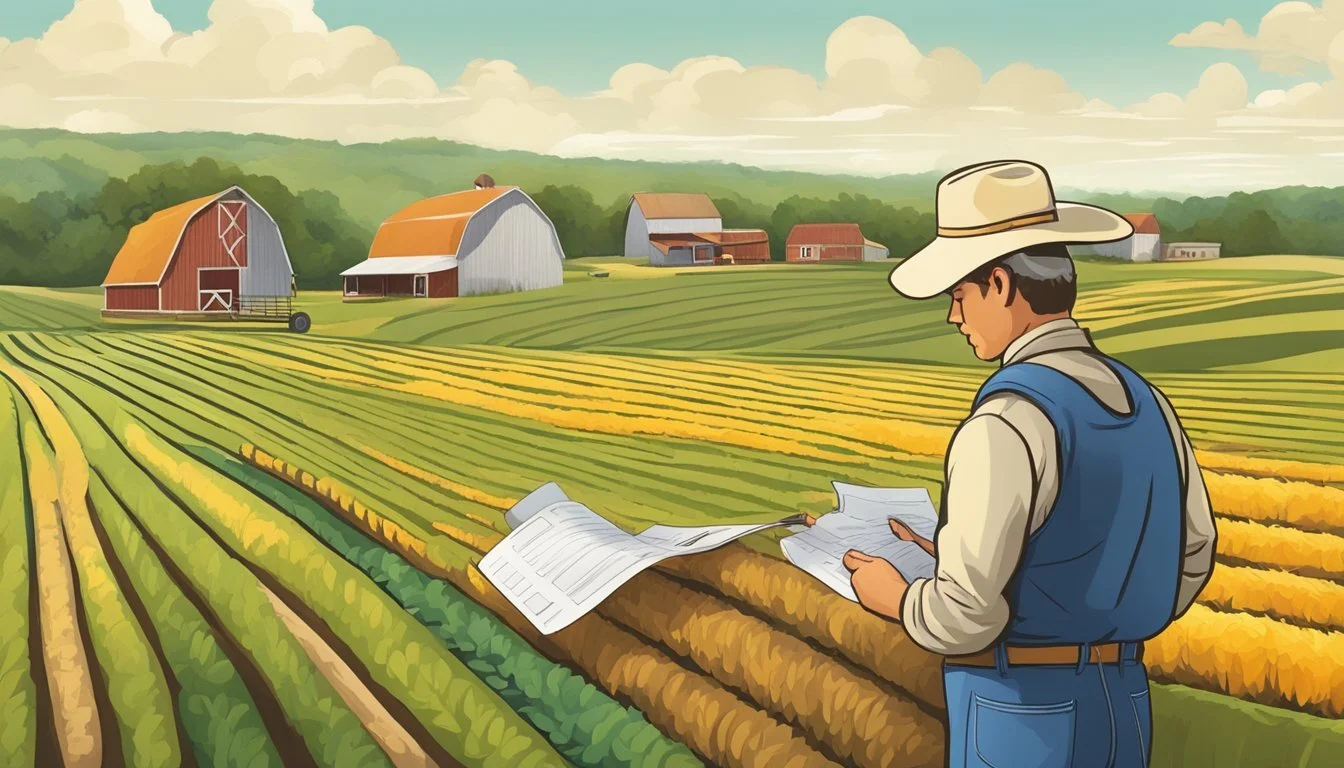Missouri Farm Land for Lease
Opportunities and Insights
This Article is Part of Our Guide on Navigating Agricultural Leases Across the US
Missouri offers a diverse range of agricultural land for lease, catering to farmers and landowners with various needs and interests. Farm land for lease can include plots suitable for crop production, livestock grazing, hunting, and other rural enterprises. The state's rich agricultural heritage and supportive community make it an attractive location for both established and aspiring farmers looking to expand operations or start new ventures. With a mix of terrains and climates across regions, Missouri farm land available for lease provides opportunities that range from small acreage for specialty farming to extensive tracts suitable for large-scale agriculture.
The process of leasing farm land in Missouri involves understanding current market rates, lease agreements, and land use potential. Landowners and potential lessees must navigate these factors carefully to ensure a mutually beneficial arrangement. In recent years, the approach to farm leases has evolved, reflecting changes in agricultural practices, economic conditions, and land values. Flexibility and clear communication between parties are key to successful leasing relationships, which can lead to long-term stability and productivity of Missouri's farm land.
Understanding the Missouri Farm Lease Market
Missouri's agricultural landscape is significantly shaped by its farm lease market, with a considerable portion of the state's farmland operated by tenants rather than landowners. This dynamic plays a critical role in the state’s agricultural economy and offers a multitude of opportunities for both landowners and farmers.
Importance of Land Leases for Farming
Land leases in Missouri are a vital aspect of the farming industry. They provide farmers with access to additional acreage without the high overhead cost associated with purchasing land. For landowners, leasing out their land can be a stable source of income. In Missouri, approximately 35% of the agricultural land, which includes crop, pasture, and woodland acreage, is leased to tenants annually.
Profile of Missouri's Leasable Farm Land
Missouri boasts a diverse array of leasable farmland, encompassing various types of terrain suitable for different kinds of agricultural uses. The state's leasable farm land includes irrigated row-crop land, predominantly used for growing corn and soybean, pasture land, and specialized areas for crops like rice. For instance, irrigated row-crop land saw a rental rate of $195.88 per acre in 2021, with irrigated rice land fetching around $204.00 per acre.
Current Trends in Missouri Farm Land Leasing
The farm lease market in Missouri has historically leaned towards fixed cash leases and crop-share arrangements. However, recent trends indicate a growing interest in flexible-cash leases where the payment to the landowner is tied to the farm’s performance. These types of leases can offer a more equitable distribution of risks and returns between the landowner and the tenant. Rental rates can vary considerably by county and are influenced by factors such as land quality, location, and the type of farming suitable for the land.
Land leasing remains a prominent and evolving part of Missouri's agriculture sector, reflecting changing market conditions and farming practices.
Types of Farm Leases in Missouri
Missouri offers a range of farm lease agreements that cater to diverse agricultural operations, providing flexibility and financial arrangements suited to various types of land use.
Cash Rent Leases
Cash rent leases are agreements where the lessee pays a fixed amount of money per acre or a lump sum for the use of land. As of data collected, irrigated row-crop land had rental rates of $195.88 per acre, indicating a premium over dryland row-crop land due to the added benefit of irrigation for crops like corn and soybeans.
Flexible Cash Rent Leases
Flexible cash rent leases tie the rental rate to the farm's revenue, which can provide a more equitable outcome for both landowner and tenant. In Missouri, the specifics of the arrangement, such as base payment and maximum payment, are typically agreed upon before the production season commences. The base payment represents the minimum rent the landowner will receive.
Crop Share Leases
Crop share leases involve sharing the costs and revenue of the crop between the landowner and the farmer. The landowner typically receives a portion of the crop as rent, which can be advantageous during higher yield years but requires both parties to share the risk of crop failure or low market prices.
Hunting Leases
Finally, hunting leases in Missouri provide an opportunity to lease land specifically for hunting purposes. Landowners can generate additional income by allowing hunting of popular wildlife such as deer and turkey on their property, often during specific seasons, while maintaining the rights to cultivate or raise cattle on the same land. This type of lease helps in managing wildlife populations and contributes to conservation efforts.
By choosing the appropriate lease type, Missouri landowners and farmers can establish agreements that best suit their land's potential and their financial goals.
Determining Rental Rates
When leasing farmland in Missouri, understanding current rental rates is crucial. Land quality, crop yield, and geographical location significantly influence these rates.
Factors Affecting Rental Rates
Several key factors impact farmland rental rates:
Land Quality: High-quality land commands higher rental rates due to better productivity and crop yield potential.
Local Market Demand: Areas with higher demand for farmland rental can drive up the rates.
Crop Yield History: Land that consistently produces higher yields is often more valuable.
Access to Water: Availability of irrigation can enhance land value and rental cost.
Amenities and Improvements: Well-maintained buildings, fences, and facilities can add to the rental price.
Cash Rental Rates by County
Rental rates can vary notably by county, reflecting the productivity and demand in those areas. A table can effectively display the average cash rental rates for different counties:
County Row-Crop Land ($/acre) Wheat Fields ($/acre) Example County 1 $150.00 $115.00 Example County 2 $145.00 $110.00 Example County 3 $155.00 $120.00
Farmers should note that these are average figures and actual rental rates can differ based on the specific attributes of the land in question. Rental rates for irrigated land, which can support a variety of crops including corn and soybeans, may be higher due to the increased potential for crop yield.
It is important for both landowners and those looking to rent to stay informed on the latest rental rate trends and consider how individual farm features affect its leasing value.
Legal Aspects of Farm Leasing
When entering into a farm lease in Missouri, it’s vital to understand legal requirements and standards that protect both the tenant and the landowner. A properly executed lease agreement lays out the terms and conditions of the tenancy, serving as a legal foundation for the relationship between the parties involved.
Essentials of a Lease Agreement
A lease agreement should clearly define the expectations and obligations of each party. Key components of a lease should include:
Duration: The length of the lease term, with start and end dates.
Rent: The amount of rent and payment schedule.
Use of Property: Specific details on what the tenant is allowed to do on the land.
Improvements/Repairs: Guidelines for modifications, improvements, and who is responsible for repairs.
Conservation Practices: Expectations for soil conservation and land care.
For the lease to be recognized as valid and enforceable, it should:
Be in writing, especially as verbal agreements can lead to misunderstandings and are difficult to prove.
Be signed by both the tenant and the landowner.
Outline rights and responsibilities, reducing disputes arising from ambiguous oral agreements.
Tenant and Landowner Rights
Rights of the Tenant include:
The right to use the property for agricultural purposes as stated in the lease.
The right to privacy, making sure the landowner has defined conditions for entry.
The right to renewal or first refusal rights, if stated.
Rights of the Landowner include:
Right to receive rent in the agreed amount and time.
Right to inspect the property, according to terms set in the lease.
Right to enforce the lease terms and take legal action if necessary.
Maximizing Farm Land Use
When optimizing land use in Missouri, farm operators target two main areas: enhancing agricultural productivity and supporting diverse wildlife habitats. These objectives require specific approaches and practices that are tailored to the landscape and its potential.
Agricultural Best Practices
Improving crop yield and overall production efficiency is paramount to maximizing the use of farmland. They have found that rotational planting and precision agriculture play vital roles in this regard. For instance, rotating between row crops such as corn and soybeans with wheat can help maintain the fertility of the soil and break cycles of pests and diseases. Precision agriculture involves using advanced technologies like GPS-guided equipment to plant and harvest crops with minimal waste and maximum efficiency.
Example of Rotational Planting Schedule:
Year 1: Corn (enhances soil structure)
Year 2: Soybeans (fixes nitrogen in the soil)
Year 3: Wheat (reduces pest pressure)
Additionally, integrating cover crops such as clover or rye during off-seasons maintains soil health and reduces erosion. Good irrigation practices and soil testing ensure that crops receive the optimal amount of nutrients and water, thus boosting agricultural output.
Cultivating Productive Wildlife Habitats
To support wildlife, farmers can allocate portions of their land for natural habitats. These areas serve essential purposes for various species, including breeding, feeding, and shelter. Establishing food plots with specific plants attracts and nourishes wildlife, including deer and turkey. When designing these spaces, the choice of crops is critical; they often include a mix of grains like sorghum, (how long does sorghum last?) legumes, and other forage plants that are attractive food sources for wildlife.
Example of Wildlife Food Plot Composition:
For Deer: A mix of clover, alfalfa, and oats (how long do oats last?)
For Turkey: A mix of chufa, corn, and sorghum
For Fish: Aquatic plants and algae management in farm ponds
Shelterbelts and buffer zones that include native grasses, shrubs, and trees not only protect soil and water but also offer cover for wildlife. In tandem with agriculture, these wildlife habitats can be balanced to provide ecological benefits while still maintaining land productivity for crops and hay production.
Resources and Support for Missouri Tenants and Landowners
Missouri tenants and landowners looking to navigate the complexities of farm leasing have access to robust resources and educational support aimed at fostering knowledge and market insights.
University of Missouri Extension Services
The University of Missouri Extension Services offers a wealth of information for both landowners and tenants. They provide detailed guides and resources pertaining to various types of lease agreements, such as flexible cash leases, cash rental rates, crop-share leases, and the intricacies involved therein. These resources are created to help parties understand the financial and operational aspects of farm leasing, ensuring they are equipped with the necessary knowledge to make informed decisions.
Flexible Cash Leases: They emphasize the variability in rent payments based on crop revenue, and outline the importance of establishing a base payment and maximum payment structure.
Cash Rental Rates: By conducting surveys, the University of Missouri Extension Services keeps parties updated with the latest rental trends and rates, contributing to transparent marketing practices.
Crop-Share Leases: They share insights on average acreage, lease renewal frequencies, and tenure, which can guide stakeholders in setting realistic expectations for crop-share agreements.
Farm Lease Education Programs
MU Extension goes beyond providing static information by actively engaging with the community through farm lease education programs. These are designed to facilitate better understanding and negotiation skills that are critical for both landowners and tenants.
Educational Materials and Workshops: These resources range from online articles to in-person seminars, where participants can delve into topics such as property descriptions, periods of lease, rental agreements, and operating expenses.
Conservation and New Practices: MU Extension provides guidance on implementation of conservation practices and integrating new technology, which is vital in today's rapidly evolving agricultural sector.
By making use of these tailored resources, Missouri's agricultural community can confidently manage lease arrangements and cultivate successful partnerships.
Market Opportunities and Challenges
Leasing farm land in Missouri presents a dynamic landscape where market trends significantly affect leasing terms and revenue opportunities, setting the stage for evolving practices and economic considerations for both landowners and tenants.
Impact of Market Trends on Leasing
Missouri has observed a substantial trend where irrigated lands command higher rental rates due to their yield assurance. Specifically, the rental rate for irrigated row-crop land was reported at $195.88 per acre, which is $48.45 more than dryland. The shift towards these lands reflects the emphasis on maximizing output but also highlights the escalating costs for tenants, influencing lease agreement negotiations. Real estate agents in Missouri facilitate these transactions, and their role becomes increasingly pivotal as they must stay abreast of current market rates and aid clients in securing optimal lease terms.
Example of current market rates:
Irrigated row-crop land: $195.88/acre
Dryland row-crop land: Below $147.43/acre
Irrigated rice land: $204.00/acre
Farmers and landowners must carefully consider these market trends in their lease agreements to ensure they remain competitive and profitable.
Future Outlook for Missouri Farm Land Leasing
The Lease Agreements in Missouri's farmland are diverse, yet there's a projected trend towards increased costs. An expert anticipates over a 10 percent hike in farmland lease costs, which would follow the upwards trajectory of farmland values. Such changes necessitate a stronger focus on marketing to ensure leased land remains an attractive and viable investment. The revenue from leasing activities might see growth alongside these cost increases, but this will largely depend upon the ability to negotiate lease terms that reflect the inherent risk and potential of the acreage in question.
Key factors influencing future outlook:
Increase in leasing costs potentially over 10%
Amplified role of marketing to maintain land attractiveness
The balancing act between cost increase and revenue potential
A dynamic market compels both tenants and landowners to adapt, evaluating lease structures such as flexible-cash leases or crop-share leases, ensuring they align with changing economic landscapes.
Advantages of Leasing Over Buying
When farmers in Missouri consider expanding their operations, they frequently weigh the pros and cons of leasing versus buying additional farmland. Each approach has its merits, but leasing can offer distinct advantages over purchasing:
Financial Flexibility: Leasing farmland allows operators to utilize additional acreage for agriculture without the significant upfront investment required to purchase the property. It provides a level of financial flexibility that buying does not, freeing up capital for other uses within the farm business.
Reduced Risk: With leasing, the risk associated with land value fluctuations is borne by the landowner, not the tenant farmer. This separation cushions lessees from potential financial losses should the market value of the land decrease.
Tax Benefits: Those who lease farmland rather than buying may avoid paying property taxes on that land. Instead, they can allocate their resources elsewhere within their farming operations.
Stewardship and Community Support: Leasing arrangements can contribute positively to the local community by:
Providing opportunities to beginning farmers
Maintaining the agricultural character of the landscape
Fostering land stewardship aligned with the owner's conservation goals
Lease Structures: A variety of lease agreements offer the lessee considerable versatility, from annual to multi-year contracts:
Fixed Cash Leases: Ensure predictable costs
Flexible Cash Rent: Can be adjusted based on market conditions
Sharecropping: Aligns the interests of landowner and tenant by sharing risks and returns
In conclusion, leasing farmland in Missouri presents a strategic option for farmers seeking to expand operations while mitigating financial risks and enhancing liquidity. The choice to lease rather than purchase farmland can have significant implications for the financial stability and growth potential of a farming operation.
Contact and Notification Systems
When leasing farmland in Missouri, staying informed on available properties is vital. Efficient contact and notification systems can streamline the process of finding and securing land leases.
Setting Up Email Notifications for Lease Opportunities
Farmers and potential lessees can subscribe to email notifications to stay updated on new lease opportunities. To set up these alerts, one must typically:
Visit a land listing website or a platform specialized in agricultural property rentals.
Create an account with accurate contact information.
Configure alert settings to match specific leasing interests, like location, size, and price range.
Opt-in for regular updates to ensure prompt notifications upon the listing of new properties.
Example Email Alert Configuration:
Preference Options Frequency Daily, Weekly, Monthly Property Type Crop land, Pasture, Mixed use County/Area Specific counties or regions in Missouri Size Range (acres) eg. 0-50, 51-200, 200+ Price Range/year eg. $0 - $5,000, $5,001 - $20,000, $20,000+
By tailoring these settings, individuals can receive relevant lease opportunities directly to their inbox, thus increasing the chances of identifying the right farmland to rent in a timely fashion.
Regional Variations in Missouri Leases
Within Missouri, leases vary largely based on location and regional factors that affect agricultural production and market demand.
Case Study: Leasing Trends in Marion County
In Marion County, leasing practices reflect both the economic and agrarian dynamics of this region. The county's proximity to critical transport routes, such as the Mississippi River, may contribute to a slightly higher market interest, and consequently, its land leasing rates can be subject to more significant fluctuations when compared to more landlocked areas of Missouri.
Leasing Rates: Reports indicate that the rental prices for farmland are influenced by the type of crop grown and other county-specific factors, such as soil quality and accessibility to markets.
Row-Crop Ground: The leasing rates for row-crop ground have a higher average in Marion County due to its fertile soil and strong agricultural productivity.
Pasture Land: Conversely, pasture land typically commands lower rental rates, reflecting its different use and management requirements.
The economic landscape of Marion County means that landowners and farmers need to stay informed about current leasing trends to negotiate fair rental prices effectively. It's also imperative that they consider factors beyond the mere dollar amount per acre, such as lease duration, tenant farming practices, and long-term land maintenance.
Personalizing the Lease Experience
In Missouri, customizing the farm lease to align with the specific desires of both the tenant and the landowner ensures a mutually beneficial agreement. This process is essential for maximizing the value of the land, whether it is for residence, commercial uses, or agricultural production.
Identifying Individual Needs and Preferences
Tenant Preferences:
Residential purposes: Tenants looking for a residence may prioritize the landscape aesthetics and proximity to local amenities.
Commercial farming: Those intending to grow crops will focus on soil quality, available water sources, and accessibility for machinery.
Landowner Considerations:
Yield maximization: Landowners interested in profit will seek tenants with a track record of responsible land usage and agricultural productivity.
Conservation: Some may prioritize sustainable farming practices to maintain the quality and health of the landscape.
When discussing farm leases, both parties must consider:
Lease Duration: Determine whether a short-term annual lease or a longer multi-year contract is suitable, keeping in mind crop rotation and investment recovery periods.
Rental Rates: Calculate fair market value rental rates to ensure that the land for rent in Missouri provides a viable income for the landowner while remaining affordable for the tenant.
By addressing these specific needs and preferences, a tailored leasing experience can be established that benefits all involved parties.
Conclusion
Missouri's agricultural landscape provides ample opportunities for leasing farmland. Landowners lease a significant portion of the state's cropland, pasture, and woodlands, offering diverse options for prospective renters.
Factors Influencing Lease Decisions:
Economic Viability: Lease rates can vary widely, influenced by land quality, location, and market demand.
Crop Type: Specialized croplands, such as irrigated fields, often command higher rental rates.
Market Trends: Understanding the current market and future projections can help in making informed leasing decisions.
It is essential for both landowners and farmers to possess up-to-date knowledge regarding rental rates and leasing arrangements. Landowners must balance the desire for a fair return with the tenants' need for a viable operation. Tenants require access to suitable land at rates that align with their financial plans and agricultural practices.
Resources for Informed Leasing:
Extension services, often providing regional rental rate data.
Agricultural economists, for professional advice on fair and sustainable lease agreements.
In conclusion, successful leasing arrangements in Missouri hinge on transparent communication, comprehensive knowledge of the agricultural market, and a mutual commitment to the land’s long-term productivity and sustainability.












